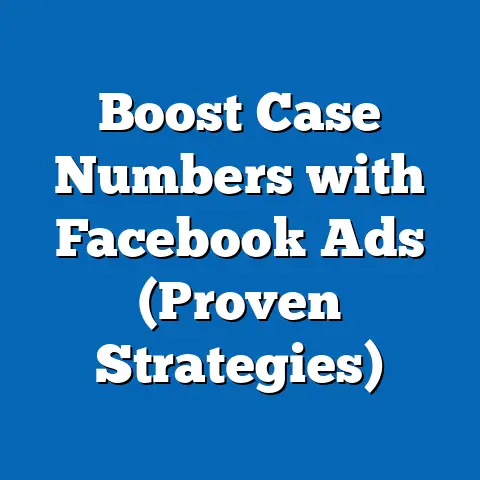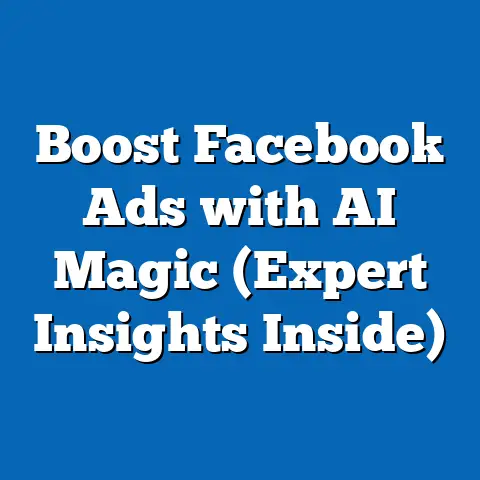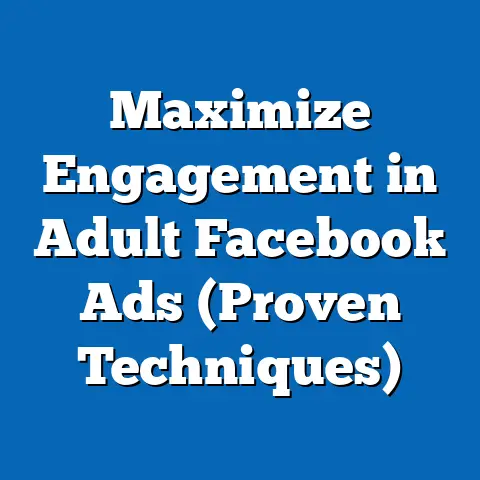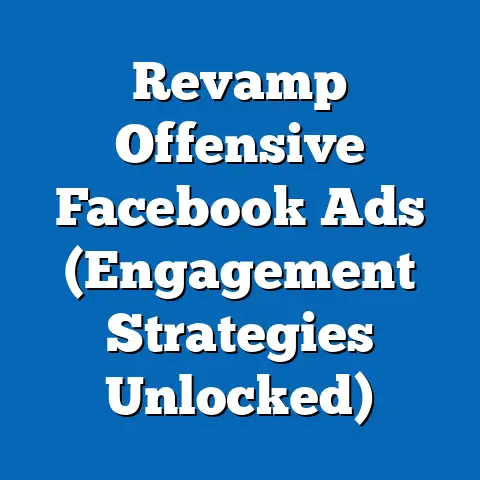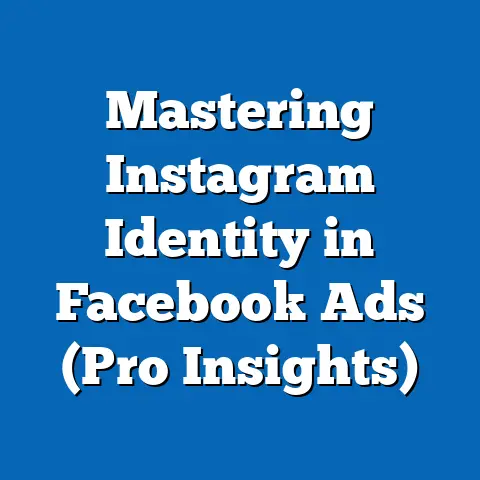Unlock Facebook Audience Tool Secrets (Expert Strategies)
In the ever-evolving landscape of digital marketing, the sheer volume of data and interactions on platforms like Facebook creates a cacophony of digital noise—irrelevant information, competing messages, and fragmented user attention. For marketers, cutting through this noise to reach the right audience with the right message is a critical challenge. Facebook’s Audience Tools, including features like Audience Insights, Custom Audiences, and Lookalike Audiences, offer powerful mechanisms to reduce this noise and refine targeting strategies.
Noise reduction in digital marketing refers to the process of filtering out irrelevant data and focusing on high-value signals that align with campaign goals. This concept is not just technical but also strategic, requiring an understanding of user behavior, platform algorithms, and evolving privacy norms. This article begins by exploring the concept of noise reduction in the context of social media marketing, delving into its defining characteristics, historical context, and societal implications, before transitioning into a comprehensive analysis of expert strategies for leveraging Facebook’s Audience Tools.
Noise Reduction in Digital Marketing: Defining Characteristics
Noise reduction, in the context of platforms like Facebook, involves minimizing irrelevant or low-impact interactions to focus on meaningful engagement. This includes identifying and targeting users who are most likely to convert, engage, or align with a brand’s objectives. Key characteristics of noise reduction include precision targeting, data segmentation, and the use of algorithmic insights to prioritize quality over quantity in audience reach.
Another critical aspect is the balance between personalization and privacy. Effective noise reduction relies on collecting and analyzing user data, but it must navigate the ethical and legal boundaries of data usage. This dual focus on relevance and responsibility shapes how marketers approach audience targeting in the digital age.
Historical Context of Noise Reduction in Digital Advertising
The concept of noise reduction in marketing predates the digital era, originating in traditional media where advertisers sought to optimize reach through demographic segmentation in newspapers, radio, and television. However, the advent of the internet and social media platforms in the early 2000s transformed the scale and complexity of this challenge. Early online advertising relied on broad banner ads and rudimentary targeting, often resulting in low engagement due to excessive noise—irrelevant ads bombarding uninterested users.
Facebook, launched in 2004, initially offered minimal targeting options, focusing on basic demographics like age and location. By 2007, with the introduction of Facebook Ads, the platform began leveraging user data to refine targeting, marking a pivotal shift toward noise reduction. The 2010s saw further advancements with tools like Custom Audiences (2012) and Lookalike Audiences (2013), enabling marketers to use first-party data and algorithmic modeling to reach high-potential users.
Societal Implications of Noise Reduction
The societal impact of noise reduction in digital marketing is multifaceted, influencing consumer behavior, privacy norms, and economic dynamics. On one hand, effective noise reduction enhances user experience by delivering relevant content, reducing ad fatigue, and fostering trust between brands and consumers. Studies suggest that personalized ads can increase engagement rates by up to 40%, as reported by a 2021 Statista survey, underscoring the value of tailored messaging.
Conversely, the reliance on data for noise reduction raises significant privacy concerns. High-profile data breaches and misuse scandals have fueled public skepticism about how platforms like Facebook handle personal information. This tension has broader implications for societal trust in technology, prompting calls for transparency and user control over data.
Economically, noise reduction drives efficiency in advertising spend, allowing businesses—especially small and medium enterprises—to achieve better returns on investment through targeted campaigns. However, it also contributes to digital divides, as sophisticated targeting tools may disproportionately benefit larger corporations with greater resources for data analytics. Additionally, the potential for “filter bubbles”—where users are exposed only to content aligning with their existing preferences—can reinforce echo chambers, impacting social discourse and polarization.
Transition to Facebook Audience Tools: A Solution to Noise
Facebook’s suite of Audience Tools emerges as a critical solution for noise reduction, offering marketers the ability to segment, analyze, and target users with unprecedented precision. These tools, including Audience Insights for demographic and behavioral data, Custom Audiences for retargeting, and Lookalike Audiences for expanding reach, are designed to filter out irrelevant users and focus on high-value segments. However, unlocking their full potential requires more than surface-level usage; it demands expert strategies that adapt to platform updates, privacy changes, and audience dynamics.
Understanding Facebook Audience Tools: A Foundation for Precision
Before diving into expert strategies, it’s essential to understand the core components of Facebook’s Audience Tools and their role in noise reduction. Audience Insights, accessible through Meta Business Suite, provides aggregated data on user demographics, interests, and behaviors, helping marketers identify high-potential segments. Custom Audiences allow businesses to upload customer data (e.g., email lists) or track website/app activity to retarget existing leads or customers.
Lookalike Audiences, on the other hand, use machine learning to identify users similar to a brand’s best customers, expanding reach without sacrificing relevance. Additionally, tools like Saved Audiences enable manual segmentation based on location, age, and interests, while Dynamic Ads automatically tailor content to user behavior. Together, these features form a robust ecosystem for reducing noise by focusing on users most likely to engage.
However, the effectiveness of these tools hinges on how they are deployed. Basic usage often yields limited results, as algorithms favor marketers who optimize data inputs and campaign structures. The following sections outline expert strategies to unlock the full potential of these tools, addressing technical, creative, and ethical considerations.
Expert Strategy 1: Mastering Data Inputs for Custom Audiences
One of the most powerful ways to reduce noise is through Custom Audiences, which allow marketers to target users based on first-party data. The secret lies in the quality and granularity of the data uploaded. For instance, segmenting email lists by purchase history, engagement level, or product interest ensures that retargeting campaigns address specific user needs rather than casting a wide net.
Experts recommend using Customer Relationship Management (CRM) systems to organize data before uploading it to Facebook. A 2022 study by HubSpot found that segmented email campaigns achieve 30% higher open rates, a principle that extends to social media retargeting. Additionally, integrating website pixel data or app events (e.g., “Add to Cart” actions) allows for dynamic retargeting of users who have shown intent but haven’t converted.
Privacy compliance is critical here. With regulations like GDPR and the California Consumer Privacy Act (CCPA), marketers must ensure data is collected with consent and anonymized where required. Failure to do so not only risks legal penalties but also erodes consumer trust, amplifying noise through negative brand sentiment.
Expert Strategy 2: Leveraging Lookalike Audiences for Scalable Reach
Lookalike Audiences are a game-changer for expanding reach while maintaining relevance, but their success depends on the source audience used to build them. Experts suggest starting with high-value Custom Audiences—such as past purchasers or engaged leads—rather than broad website visitors. A smaller, high-quality source audience (1,000-5,000 users) often yields better results than a larger, less specific one, as the algorithm can more accurately identify similar traits.
Another advanced tactic is to adjust the similarity percentage (1%-10%) based on campaign goals. A 1% Lookalike Audience prioritizes close matches for higher conversion rates, while a 5%-10% audience broadens reach for awareness campaigns. Testing multiple percentages and monitoring performance metrics like cost-per-click (CPC) and return on ad spend (ROAS) is essential for optimization.
Expert Strategy 3: Harnessing Audience Insights for Behavioral Targeting
Audience Insights is often underutilized, yet it offers a wealth of data for noise reduction through behavioral targeting. By analyzing user interests, purchase behaviors, and device usage, marketers can uncover niche segments that align with their products or services. For example, a fitness brand might discover that a subset of its audience frequently engages with outdoor activities, allowing for tailored messaging around hiking gear or adventure challenges.
Experts advocate for a “test and learn” approach with Audience Insights, creating Saved Audiences based on different interest combinations and measuring engagement rates. A 2023 report by Social Media Examiner noted that campaigns using interest-based targeting saw a 25% lift in click-through rates compared to broad demographic targeting. However, over-narrowing can limit reach, so balancing specificity with scale is key.
Cultural and generational nuances also play a role here. Younger audiences (Gen Z, aged 18-26) may prioritize trending topics or influencer-driven content, while older segments (Baby Boomers, aged 59-77) might respond better to value-driven messaging. Audience Insights helps uncover these differences, enabling marketers to craft resonant campaigns that cut through generational noise.
Expert Strategy 4: Optimizing Creative for Audience Segments
Even the most precise targeting falls short without compelling creative content. Noise reduction isn’t just about reaching the right audience; it’s about engaging them with relevant messaging. Experts emphasize the importance of tailoring ad copy, visuals, and formats to specific audience segments identified through Facebook’s tools.
For instance, Dynamic Ads automatically adjust product recommendations based on user behavior, reducing noise by showing items users are likely to purchase. A/B testing different creative elements—such as headlines, images, and calls-to-action—within segmented audiences can further refine what resonates. According to a 2022 Meta study, campaigns with personalized creative saw a 35% increase in conversion rates.
Cultural sensitivity is also critical. Ads targeting diverse audiences must avoid stereotypes and reflect authentic representation, as missteps can amplify noise through backlash or disengagement. Marketers should leverage Audience Insights to understand cultural preferences and test creative variations accordingly.
Expert Strategy 5: Adapting to Privacy Changes and Algorithm Updates
The digital marketing landscape is in constant flux, with privacy changes and algorithm updates reshaping how Audience Tools function. Apple’s iOS 14.5 update in 2021, which introduced App Tracking Transparency (ATT), significantly reduced the data available for targeting on Facebook, increasing noise for marketers reliant on third-party tracking. Meta’s response—enhancing on-platform measurement tools like Conversions API—requires marketers to adapt by prioritizing first-party data collection.
Experts recommend building owned data assets, such as email lists or loyalty programs, to fuel Custom Audiences independently of third-party cookies. Additionally, staying informed about Meta’s policy updates through official blogs and industry reports is crucial for anticipating shifts in targeting capabilities. A proactive approach to privacy compliance not only mitigates noise from regulatory penalties but also builds trust, a key differentiator in a skeptical digital ecosystem.
Generational Dynamics in Audience Targeting: A Deeper Dive
Generational differences add another layer of complexity to noise reduction, as each cohort interacts with digital platforms in unique ways. Gen Z, shaped by mobile-first experiences and social movements, often prioritizes authenticity and social impact in brand messaging. Millennials (aged 27-42), balancing career and family priorities, value convenience and personalization, often responding well to retargeting via Custom Audiences.
Gen X (aged 43-58), often overlooked, represents a tech-savvy yet pragmatic group, responsive to value-driven offers and nostalgia-based creative. Baby Boomers, increasingly active on social media, require accessible formats and trust-building content, often engaging through interest-based targeting. Understanding these nuances—supported by Audience Insights data—allows marketers to reduce noise by aligning campaigns with generational preferences.
However, diversity within generations must be acknowledged. Not all Millennials are tech-obsessed, nor are all Boomers digitally averse. Economic, cultural, and geographic factors create sub-segments within each cohort, requiring marketers to layer demographic data with behavioral insights for true precision.
Implications for Society, Culture, and the Workplace
The strategic use of Facebook Audience Tools extends beyond marketing, influencing broader societal and cultural trends. In society, precision targeting can enhance consumer empowerment by delivering relevant information, but it also risks exacerbating filter bubbles, as algorithms reinforce existing biases. Culturally, tailored messaging can celebrate diversity through localized or community-specific campaigns, yet it demands ethical oversight to avoid perpetuation of stereotypes.
In the workplace, mastery of Audience Tools is becoming a critical skill for marketing teams, driving demand for data analysts and privacy specialists. Small businesses, empowered by affordable targeting options, can compete with larger players, reshaping economic dynamics. However, the learning curve and resource demands of these tools may widen gaps between tech-savvy and under-resourced firms, mirroring broader digital inequities.
Forward-Looking Insights: The Future of Noise Reduction
Looking ahead, the trajectory of noise reduction and audience targeting on platforms like Facebook will be shaped by technological innovation and regulatory evolution. Advances in artificial intelligence and machine learning promise even more precise targeting, potentially integrating predictive analytics to anticipate user needs before they arise. However, the push for privacy—evident in initiatives like the phasing out of third-party cookies—will continue to challenge marketers to innovate within constraints.
The rise of the metaverse, with Meta at the forefront, could redefine audience engagement, offering immersive environments for targeting. Yet, uncertainties remain around user adoption and ethical implications. Marketers must remain agile, balancing technological opportunities with a commitment to transparency and trust-building.
Conclusion: Cutting Through the Noise with Expert Precision
Unlocking the secrets of Facebook Audience Tools requires more than technical know-how; it demands a strategic, ethical, and adaptable approach to noise reduction. From mastering Custom Audiences to optimizing creative for generational nuances, the expert strategies outlined in this article provide a roadmap for precision targeting in a crowded digital landscape. As societal expectations and platform capabilities evolve, marketers must stay ahead of the curve, leveraging data-driven insights while respecting user privacy.
The implications of these tools extend far beyond individual campaigns, shaping consumer trust, cultural representation, and economic opportunity. While the future holds both promise and uncertainty, one thing is clear: reducing digital noise is not just a marketing challenge but a societal imperative, requiring collaboration between platforms, brands, and users to create a more meaningful online experience.

